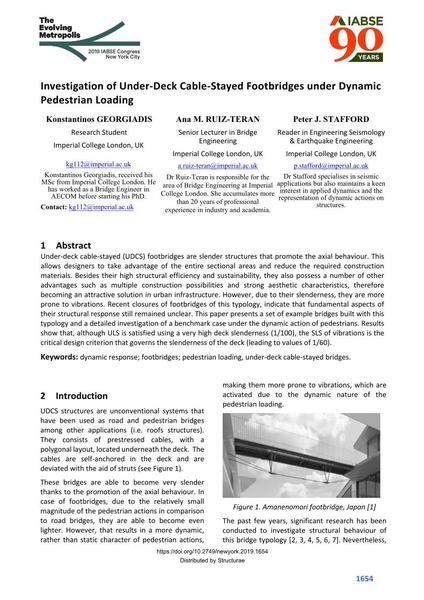Investigation of Under-Deck Cable-Stayed Footbridges under Dynamic Pedestrian Loading

|
|
|||||||||||
Détails bibliographiques
| Auteur(s): |
Konstantinos Georgiadis
(Imperial College London, UK)
Ana M. Ruiz-Teran (Imperial College London, UK) Peter J. Stafford (Imperial College London, UK) |
||||
|---|---|---|---|---|---|
| Médium: | papier de conférence | ||||
| Langue(s): | anglais | ||||
| Conférence: | IABSE Congress: The Evolving Metropolis, New York, NY, USA, 4-6 September 2019 | ||||
| Publié dans: | The Evolving Metropolis | ||||
|
|||||
| Page(s): | 1654-1661 | ||||
| Nombre total de pages (du PDF): | 8 | ||||
| DOI: | 10.2749/newyork.2019.1654 | ||||
| Abstrait: |
Under-deck cable-stayed (UDCS) footbridges are slender structures that promote the axial behaviour. This allows designers to take advantage of the entire sectional areas and reduce the required construction materials. Besides their high structural efficiency and sustainability, they also possess a number of other advantages such as multiple construction possibilities and strong aesthetic characteristics, therefore becoming an attractive solution in urban infrastructure. However, due to their slenderness, they are more prone to vibrations. Recent closures of footbridges of this typology, indicate that fundamental aspects of their structural response still remained unclear. This paper presents a set of example bridges built with this typology and a detailed investigation of a benchmark case under the dynamic action of pedestrians. Results show that, although ULS is satisfied using a very high deck slenderness (1/100), the SLS of vibrations is the critical design criterion that governs the slenderness of the deck (leading to values of 1/60). |
||||
| Mots-clé: |
passerelles
|
||||


